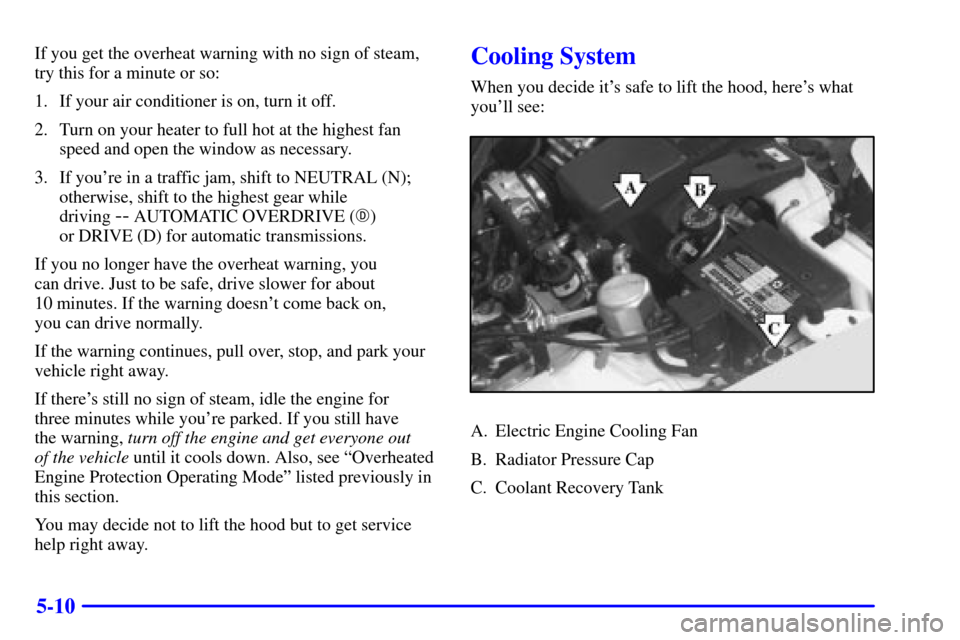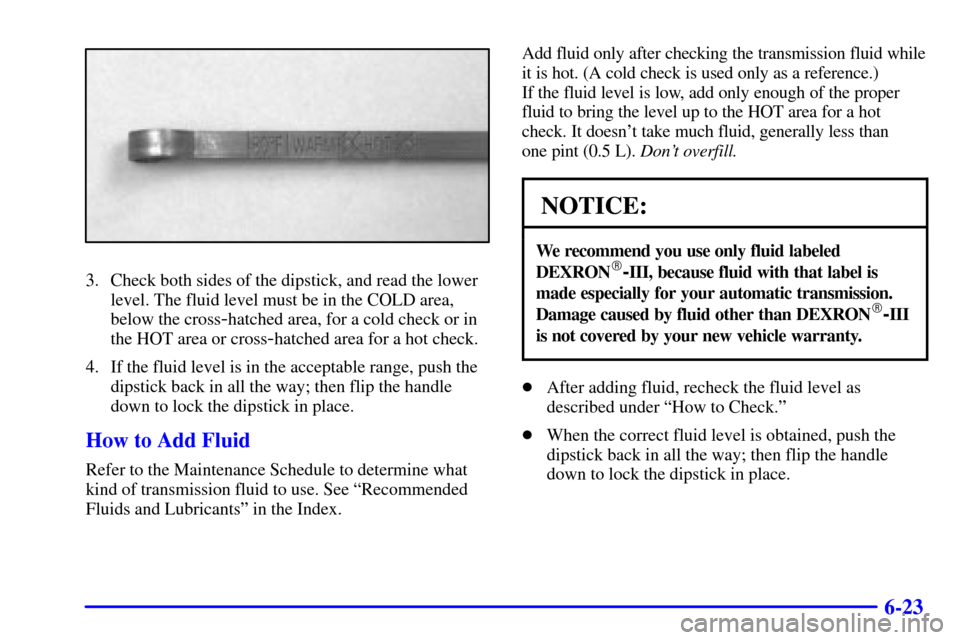Page 230 of 363

5-10
If you get the overheat warning with no sign of steam,
try this for a minute or so:
1. If your air conditioner is on, turn it off.
2. Turn on your heater to full hot at the highest fan
speed and open the window as necessary.
3. If you're in a traffic jam, shift to NEUTRAL (N);
otherwise, shift to the highest gear while
driving
-- AUTOMATIC OVERDRIVE (�)
or DRIVE (D) for automatic transmissions.
If you no longer have the overheat warning, you
can drive. Just to be safe, drive slower for about
10 minutes. If the warning doesn't come back on,
you can drive normally.
If the warning continues, pull over, stop, and park your
vehicle right away.
If there's still no sign of steam, idle the engine for
three minutes while you're parked. If you still have
the warning, turn off the engine and get everyone out
of the vehicle until it cools down. Also, see ªOverheated
Engine Protection Operating Modeº listed previously in
this section.
You may decide not to lift the hood but to get service
help right away.
Cooling System
When you decide it's safe to lift the hood, here's what
you'll see:
A. Electric Engine Cooling Fan
B. Radiator Pressure Cap
C. Coolant Recovery Tank
Page 241 of 363
5-21
Changing a Flat Tire
If a tire goes flat, avoid further tire and wheel damage
by driving slowly to a level place. Turn on your hazard
warning flashers.
CAUTION:
Changing a tire can cause an injury. The vehicle
can slip off the jack and roll over you or other
people. You and they could be badly injured.
Find a level place to change your tire. To help
prevent the vehicle from moving:
1. Set the parking brake firmly.
2. Put an automatic transmission shift lever in
PARK (P), or shift a manual transmission to
FIRST (1) or REVERSE (R).
3. Turn off the engine.
To be even more certain the vehicle won't move,
you can put blocks at the front and rear of the
tire farthest away from the one being changed.
That would be the tire on the other side of the
vehicle, at the opposite end.
The following steps will tell you how to use the jack and
change a tire.
Page 255 of 363

6-
6-1
Section 6 Service and Appearance Care
Here you will find information about the care of your vehicle. This section begins with service and fuel information,
and then it shows how to check important fluid and lubricant levels. There is also technical information about your
vehicle, and a part devoted to its appearance care.
6
-2 Service
6
-3 Fuel
6
-5 Fuels in Foreign Countries
6
-6 Filling Your Tank
6
-8 Filling a Portable Fuel Container
6
-8 Checking Things Under the Hood
6
-10 Engine Compartment Overview
6
-12 Engine Oil
6
-18 Engine Air Cleaner/Filter
6
-20 Automatic Transmission Fluid
6
-24 Manual Transmission Fluid
6
-25 Hydraulic Clutch
6
-26 Rear Axle
6
-27 Engine Coolant
6
-30 Power Steering Fluid
6
-32 Windshield Washer Fluid
6
-33 Brakes
6
-37 Battery
6
-37 Bulb Replacement6
-43 Tires
6
-52 Appearance Care
6
-52 Cleaning the Inside of Your Vehicle
6
-54 Care of Safety Belts
6
-55 Cleaning Glass Surfaces
6
-56 Cleaning a Removeable Roof Panel
6
-56 Cleaning the Outside of Your Vehicle
6
-57 Cleaning Your Convertible Top
6
-58 Cleaning Aluminum or Chrome-Plated
Wheels (If Equipped)
6
-59 Underbody Maintenance
6
-60 GM Vehicle Care/Appearance Materials
6
-61 Vehicle Identification Number (VIN)
6
-61 Service Parts Identification Label
6
-62 Electrical System
6
-68 Replacement Bulbs
6
-69 Capacities and Specifications
6
-70 Normal Maintenance Replacement Parts
Page 264 of 363
6-10 Engine Compartment Overview
When you open the hood of the 3800 V6 engine, you'll see:
A. Engine Coolant Reservoir
B. Battery
C. Radiator Pressure Cap
D. Engine Oil Fill Cap
E. Automatic Transmission Fluid
Dipstick (If Equipped)F. Windshield Washer
Fluid Reservoir
G. Engine Cooling Fans
H. Engine Air Cleaner/Filter
I. Power Steering Fluid ReservoirJ. Engine Oil Dipstick
K. Brake Fluid Reservoir
L. Clutch Fluid Reservoir
(If Equipped)
Page 265 of 363
6-11
When you open the hood of the 5.7L V8 engine, you'll see:
A. Engine Coolant Reservoir
B. Battery
C. Radiator Pressure Cap
D. Engine Oil Dipstick
E. Engine Oil Fill CapF. Windshield Washer
Fluid Reservoir
G. Engine Cooling Fans
H. Automatic Transmission Fluid
Dipstick (If Equipped)I. Engine Air Cleaner/Filter
J. Power Steering Fluid Reservoir
K. Brake Fluid Reservoir
L. Clutch Fluid Reservoir
(If Equipped)
Before closing the hood, be sure all the filler caps are on.
Then pull the hood down and close it firmly.
Page 274 of 363
6-20
4. Close the cover without an overlap (clamp will not
latch with an overlap) and latch the clamps.
Automatic Transmission Fluid
When to Check and Change
A good time to check your automatic transmission fluid
level is when the engine oil is changed.
Change both the fluid and filter every 15,000 miles
(25 000 km) if the vehicle is mainly driven under one or
more of these conditions:
�In heavy city traffic where the outside temperature
regularly reaches 90�F (32�C) or higher.
�In hilly or mountainous terrain.
�Uses such as high performance operation.
�When doing frequent trailer towing.
�Uses such as found in taxi, police or delivery service.
If you do not use your vehicle under any of
these conditions, change the fluid and filter every
50,000 miles (83 000 km).
See ªScheduled Maintenance Servicesº in the Index.
Page 275 of 363

6-21 How to Check
Because this operation can be a little difficult, you may
choose to have this done at the dealership service department.
If you do it yourself, be sure to follow all the instructions
here, or you could get a false reading on the dipstick.
NOTICE:
Too much or too little fluid can damage your
transmission. Too much can mean that some of
the fluid could come out and fall on hot engine
parts or exhaust system parts, starting a fire. Be
sure to get an accurate reading if you check your
transmission fluid.
Wait at least 30 minutes before checking the
transmission fluid level if you have been driving:
�When outside temperatures are above 90�F (32�C).
�At high speed for quite a while.
�In heavy traffic
-- especially in hot weather.
�While pulling a trailer.To get the right reading, the fluid should be
at normal operating temperature, which is
180�F to 200�F (82�C to 93�C).
Get the vehicle warmed up by driving about
15 miles (24 km) when outside temperatures are above
50�F (10�C). If it's colder than 50�F (10�C), drive
the vehicle in AUTOMATIC OVERDRIVE (�) until
the engine temperature gage moves and then remains
steady for 10 minutes.
A cold fluid check can be made after the vehicle has been
sitting for eight hours or more with the engine off, but
this is used only as a reference. Let the engine run at idle
for five minutes if outside temperatures are 50�F (10�C)
or more. If it's colder than 50�F (10�C), you may have to
idle the engine longer. Should the fluid level be low
during this cold check, you must check the fluid hot
before adding fluid. Checking the fluid hot will give you
a more accurate reading of the fluid level.
Page 277 of 363

6-23
3. Check both sides of the dipstick, and read the lower
level. The fluid level must be in the COLD area,
below the cross
-hatched area, for a cold check or in
the HOT area or cross
-hatched area for a hot check.
4. If the fluid level is in the acceptable range, push the
dipstick back in all the way; then flip the handle
down to lock the dipstick in place.
How to Add Fluid
Refer to the Maintenance Schedule to determine what
kind of transmission fluid to use. See ªRecommended
Fluids and Lubricantsº in the Index.Add fluid only after checking the transmission fluid while
it is hot. (A cold check is used only as a reference.)
If the fluid level is low, add only enough of the proper
fluid to bring the level up to the HOT area for a hot
check. It doesn't take much fluid, generally less than
one pint (0.5 L). Don't overfill.
NOTICE:
We recommend you use only fluid labeled
DEXRON�-III, because fluid with that label is
made especially for your automatic transmission.
Damage caused by fluid other than DEXRON
�-III
is not covered by your new vehicle warranty.
�After adding fluid, recheck the fluid level as
described under ªHow to Check.º
�When the correct fluid level is obtained, push the
dipstick back in all the way; then flip the handle
down to lock the dipstick in place.